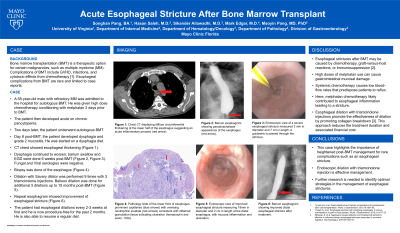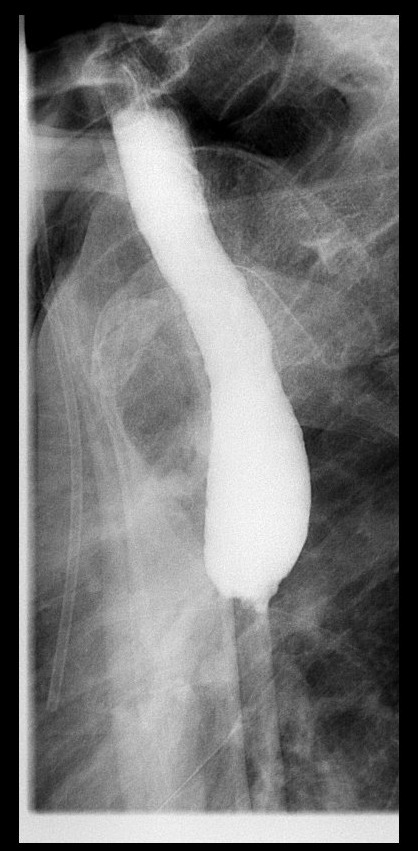Sunday Poster Session
Category: Esophagus
P0502 - Acute Esophageal Stricture After Bone Marrow Transplant
Sunday, October 22, 2023
3:30 PM - 7:00 PM PT
Location: Exhibit Hall

Has Audio
- HS
Hasan Saleh, MD
Mayo Clinic
Jacksonville, FL
Presenting Author(s)
Songhan Pang, 1, Hasan Saleh, MD2, Sikander Ailawadhi, MD2, Mark Edgar, MD2, Maoyin Pang, MD, PhD3
1University of Virginia, Jacksonville, FL; 2Mayo Clinic, Jacksonville, FL; 3Mayo Clinic Florida, Jacksonville, FL
Introduction: Bone marrow transplantation (BMT) is a treatment option for certain hematological malignancies and nonmalignant conditions. There are risks involved such as infection, graft-versus-host disease (GVHD), or organ damage. Esophageal stricture following BMT is exceptionally rare with only three cases reported in the literature. We present an intriguing case of esophageal stricture in a patient following autologous BMT.
Case Description/Methods: A 58-year-old male with refractory multiple myeloma and previously failed BMT five years prior was admitted for autologous BMT. High-dose melphalan conditioning 350mg (200 mg/m2) was administered in preparation for HSCT. He then developed a fever of 39.0 °C and pancytopenia but remained hemodynamically stable. Prophylactic cefepime was given and the microbiology panel was negative. On day 2, he received an autologous CD34/kg (4.22 x 106/kg) infusion via a peripheral catheter without acute events and was discharged 48 hours later. Five days post BMT, he endorsed cough and solid food dysphagia. Chest CT scan revealed diffuse circumferential thickening of the lower esophagus, indicating acute inflammation. Dysphagia progressively worsened under conservative management in context of severe neutropenia and thrombocytopenia. Four weeks later, a barium esophagram showed severe mid-thoracic esophageal narrowing and an EGD showed esophageal stenosis measuring 3 mm inner diameter by 7 cm long in the mid-distal esophagus. The mucosa was nodular and inflamed with sloughing. Dilation with a Savary dilator up to 8 mm was performed. Multiple biopsies showed ulceration with granulation tissue, activated capillaries, and neutrophilic exudates. Virology panel results were negative. Over the next year, the patient underwent 12 EGDs with dilations, including five total triamcinolone 40 mg injections after dilation. The stricture improved to 15mm inner diameter by 3 cm long. He was able to tolerate a regular diet.
Discussion: Esophageal strictures following BMT are exceptionally rare. The underlying mechanism may involve chemotherapy conditioning regimens, immunosuppression, and in the case of allogeneic BMT, graft-versus-host reactions. Here, high-dose melphalan conditioning likely contributed to the stricture. Common causes like GVHD and infection were ruled out or not applicable. Repeat dilations and triamcinolone injections were effective in management. This case highlights the importance of heightened post-BMT management for rare complications such an esophageal stricture.

Disclosures:
Songhan Pang, 1, Hasan Saleh, MD2, Sikander Ailawadhi, MD2, Mark Edgar, MD2, Maoyin Pang, MD, PhD3. P0502 - Acute Esophageal Stricture After Bone Marrow Transplant, ACG 2023 Annual Scientific Meeting Abstracts. Vancouver, BC, Canada: American College of Gastroenterology.
1University of Virginia, Jacksonville, FL; 2Mayo Clinic, Jacksonville, FL; 3Mayo Clinic Florida, Jacksonville, FL
Introduction: Bone marrow transplantation (BMT) is a treatment option for certain hematological malignancies and nonmalignant conditions. There are risks involved such as infection, graft-versus-host disease (GVHD), or organ damage. Esophageal stricture following BMT is exceptionally rare with only three cases reported in the literature. We present an intriguing case of esophageal stricture in a patient following autologous BMT.
Case Description/Methods: A 58-year-old male with refractory multiple myeloma and previously failed BMT five years prior was admitted for autologous BMT. High-dose melphalan conditioning 350mg (200 mg/m2) was administered in preparation for HSCT. He then developed a fever of 39.0 °C and pancytopenia but remained hemodynamically stable. Prophylactic cefepime was given and the microbiology panel was negative. On day 2, he received an autologous CD34/kg (4.22 x 106/kg) infusion via a peripheral catheter without acute events and was discharged 48 hours later. Five days post BMT, he endorsed cough and solid food dysphagia. Chest CT scan revealed diffuse circumferential thickening of the lower esophagus, indicating acute inflammation. Dysphagia progressively worsened under conservative management in context of severe neutropenia and thrombocytopenia. Four weeks later, a barium esophagram showed severe mid-thoracic esophageal narrowing and an EGD showed esophageal stenosis measuring 3 mm inner diameter by 7 cm long in the mid-distal esophagus. The mucosa was nodular and inflamed with sloughing. Dilation with a Savary dilator up to 8 mm was performed. Multiple biopsies showed ulceration with granulation tissue, activated capillaries, and neutrophilic exudates. Virology panel results were negative. Over the next year, the patient underwent 12 EGDs with dilations, including five total triamcinolone 40 mg injections after dilation. The stricture improved to 15mm inner diameter by 3 cm long. He was able to tolerate a regular diet.
Discussion: Esophageal strictures following BMT are exceptionally rare. The underlying mechanism may involve chemotherapy conditioning regimens, immunosuppression, and in the case of allogeneic BMT, graft-versus-host reactions. Here, high-dose melphalan conditioning likely contributed to the stricture. Common causes like GVHD and infection were ruled out or not applicable. Repeat dilations and triamcinolone injections were effective in management. This case highlights the importance of heightened post-BMT management for rare complications such an esophageal stricture.

Figure: Barium esophagram significant for severe mid thoracic esophageal narrowing with lack of contrast passage into the distal esophagus and upstream esophageal dilation, consistent with esophageal stricture.
Disclosures:
Songhan Pang indicated no relevant financial relationships.
Hasan Saleh indicated no relevant financial relationships.
Sikander Ailawadhi indicated no relevant financial relationships.
Mark Edgar indicated no relevant financial relationships.
Maoyin Pang indicated no relevant financial relationships.
Songhan Pang, 1, Hasan Saleh, MD2, Sikander Ailawadhi, MD2, Mark Edgar, MD2, Maoyin Pang, MD, PhD3. P0502 - Acute Esophageal Stricture After Bone Marrow Transplant, ACG 2023 Annual Scientific Meeting Abstracts. Vancouver, BC, Canada: American College of Gastroenterology.
